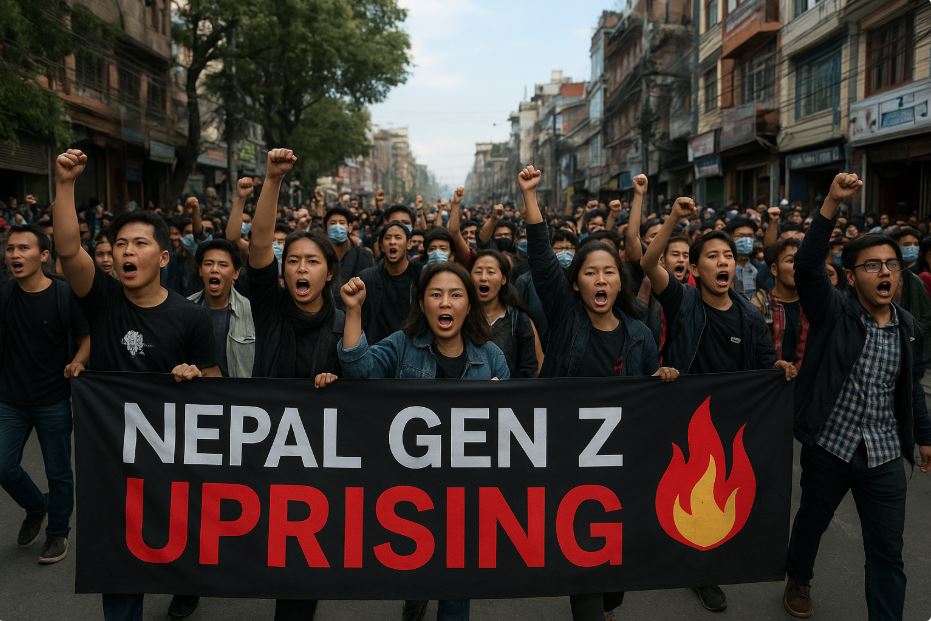Nepal’s Gen Z Protests: How a Social Media Ban Sparked an Uprising
Imagine waking up one morning and finding Facebook, YouTube, TikTok, Snapchat, and even LinkedIn blocked in your country. No way to chat, no memes, no news, no voice.That’s exactly what happened in Nepal on 4 September 2025. Within hours, frustration turned to fury. By the end of the week, streets were on fire, dozens of people were dead, and the Prime Minister had resigned.This was not just about social media. It was about a generation tired of corruption, nepotism, and broken promises. This is the story of Nepal’s Gen Z Uprising.
Quick Timeline of Events
- 4 Sept 2025: Government bans 26 social media platforms
- 7 Sept 2025: Youth mobilize online before full ban takes hold
- 8 Sept 2025: Massive protests erupt in Kathmandu, violent clashes reported
- 9 Sept 2025: Parliament building set on fire, PM Oli resigns, social media ban lifted
- Aftermath: Army deployed, curfews imposed, political crisis deepens
What Triggered the Protests? The Social Media Ban
The Nepali government introduced strict rules requiring all social media companies to register locally. When they failed to comply, 26 platforms were blocked — including:
- X (Twitter)
- YouTube
- Snapchat
- Signal
Authorities claimed the move would reduce fake news, hate speech, and cybercrime.But for Gen Z, social media wasn’t just fun. It was:
- Their news source
- Their political voice
- Their economic lifeline (small businesses, freelancers, influencers)
The ban felt like erasing an entire generation’s voice.
Why Did Gen Z Rise Up?
1. Youth Unemployment & Economic Struggles
Nepal has one of the youngest populations in South Asia. Yet job opportunities are scarce. Many are forced to migrate abroad for work.
📊 Youth unemployment in Nepal (2025 estimates)
| Factor | Rate / Status |
|---|---|
| Youth unemployment | ~20% |
| Labor migration abroad | 600,000+ young Nepalis yearly |
| Remittances share of GDP | ~24% |

Corruption & Nepotism (“Nepo Kids”)
- Viral TikTok and X trends exposed the lavish lifestyles of politicians’ children, dubbed “nepo kids.”
- Young people compared their struggles with the privileges of the elite, fueling rage.
Digital Life = Political Life
- In Nepal, social media is more than entertainment.
- It connects remote regions, spreads political campaigns, and unites the diaspora.
- Cutting it off was like cutting off the heartbeat of Gen Z politics.
The Escalation: How Protests Turned Deadly
- Maitighar Mandala, Kathmandu became the center of demonstrations.
- Security forces used tear gas, rubber bullets, and even live rounds.
- Protesters set parliament and government offices on fire.
- Air travel disrupted as the internet shutdown spread confusion.
Result: At least 19 people killed, hundreds injured, and Nepal Army deployed.
The Human Cost & Rights Concerns
- Dozens killed, hundreds injured, and many detained.
- Human rights groups, including Amnesty International, demanded investigations.
- The UN called for restraint and international media warned of instability spreading across South Asia.
Who Led the Protests?
- Unlike older movements, this was leaderless.
- Organized mostly through hashtags and viral posts before the ban.
- Youth groups like Hami Nepal supported, but the movement stayed organic and grassroots.
Political Fallout
- PM K.P. Sharma Oli resigned on 9 September 2025.
- Several ministers also quit.
- Army took control of sensitive areas.
- Nepal faces uncertainty: caretaker government, possible early elections, and a crisis of trust between Gen Z and traditional parties.
Nepal vs. Bangladesh: A Shared South Asian Struggle
The Gen Z uprising in Nepal echoes the recent protests in Bangladesh, where students and young professionals also took to the streets against corruption, unemployment, and authoritarian controls. In both countries, social media bans became a spark that united frustrated youth into powerful movements. While Nepal’s protests highlight a fight against systemic corruption, Bangladesh’s unrest showed how economic hardship and political repression can push a young population to demand change. Together, they reflect a growing trend across South Asia—where Gen Z is no longer willing to stay silent in the face of injustice.
Is Pakistan the Next Revolutionary State?
Pakistan shares many of the same frustrations now seen in Nepal and Bangladesh: youth unemployment, corruption, elite privilege, and strict internet controls. With nearly 65% of its population under 30, Pakistan’s Gen Z holds massive political power. Internet shutdowns during protests, rising censorship, and widening economic inequality have already fueled anger among young people. While Pakistan has not yet seen a full-scale “Gen Z revolution,” the conditions are building. If the ruling elite fails to address corruption and provide opportunities, Pakistan could well become the next South Asian country where youth rise up to demand change.
Regional & Global Lessons
- For South Asia:
- Internet shutdowns risk triggering bigger crises.
- Youth are not silent anymore.
- For Governments Worldwide:
- Censorship can backfire.
- Dialogue and reforms work better than bans.
- For Tech Companies:
- Registration rules vs free speech is a global challenge.
- Platforms need stronger commitments to user rights.
Final Remarks
Nepal’s Gen Z protests began with a social media ban but ended with the downfall of a Prime Minister. It shows one clear truth:
In the digital age, silencing social media can silence governments instead.
For young Nepalis, this was not just about apps on their phones. It was about dignity, jobs, fairness, and freedom. The Gen Z uprising may be over for now, but its echo will shape Nepal’s politics for years to come.
At the same time, Nepal’s story is not isolated. Bangladesh has already witnessed its own youth-led revolution, and Pakistan faces growing signs of frustration among its young population. Together, these movements highlight a South Asia where Gen Z is no longer willing to stay silent. Their collective voice is rewriting the region’s political future.